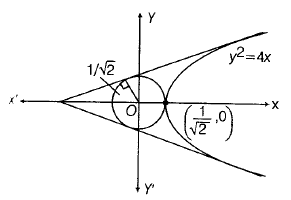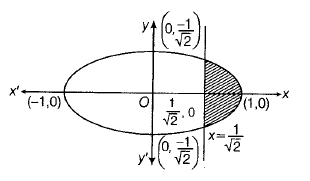Answer:
Option A,C
Explanation:
We have, Equations of circle
$x^{2}+y^{2}=\frac{1}{2}$
and equation of parabola

Let the equation of commpn tangent of parabola and circle is
$y^{}=mx^{}+\frac{1}{m}$
Since, radius of circle = $\frac{1}{\sqrt{2}}$
$\frac{1}{\sqrt{2}}$ = $\mid\frac{0+0+\frac{1}{m}}{\sqrt{1+m^{2}}}\mid$
= m4+m2-m =0
= m ± 1
$\therefore$ Equation of common tangents are
y=x+1 and y=-x-1
Intersection point of common tangent at Q(-1,0)
$\therefore$ equation of ellipse
$\frac{x^{2}}{1}+\frac{y^{2}}{1/2}=1$
where, a2=1 , b2=1/2
Now,
eccentricity $(e)=\sqrt{1-\frac{b^{2}}{a^{2}}}= \sqrt{1-\frac{1}{2}}=\frac{1}{\sqrt{2}}$
and length of latusrectum
$\frac{2b^{2}}{a}=\frac{2(\frac{1}{2})}{1}=1$

$\therefore$ Area of shadow region
= $2\int_{\frac{1}{\sqrt{2}}}^{1} \frac{1}{\sqrt{2}}\sqrt{1-x^{2}}dx$
= $\sqrt{2} [\frac{x}{2}\sqrt{1-x^{2}}+\frac{1}{2}\sin^{-1}x]_\frac{1}{\sqrt{2}}^1$
= $\sqrt{2}[(0+\frac{\pi}{4})-(\frac{1}{4}+\frac{\pi}{8})]$
= $\sqrt{2}(\frac{\pi}{8}-\frac{1}{4})=\frac{\pi -2}{4\sqrt{2}}$